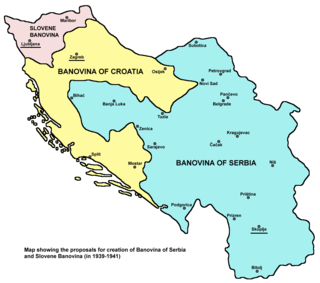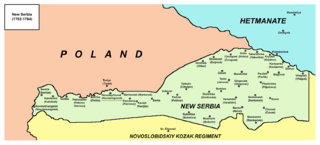 W
WThe Banovina of Serbia or Banate of Serbia, officially known as "the Serbian Lands", was a proposed administrative unit of the Kingdom of Yugoslavia. Its creation was proposed after the establishment of the Banovina of Croatia in 1939. However, due to the Axis occupation and partition of Yugoslavia in 1941, the proposal was never implemented.
 W
WBelgradkapı is a quarter in Zeytinburnu district of Istanbul, Turkey. Name of the neighborhood means Belgrade Gate in Turkish, and was named so after the Ottoman sultan Suleiman the Magnificent conquered Belgrade in 1521, modern capital of Serbia, and resettled its population to several locations in Istanbul, including the present Belgradkapı area.
 W
WThe Serbian Orthodox Church is one of the autocephalous Eastern Orthodox Christian churches. It is the second-oldest Slavic Orthodox Church in the world.
 W
WThe Hilandar Monastery is one of the twenty Eastern Orthodox monasteries in Mount Athos in Greece and the only Serbian monastery there. It was founded in 1198 by Stefan Nemanja and his son Saint Sava. St. Symeon was the former Grand Prince of Serbia (1166-1196) who upon relinquishing his throne took monastic vows and became an ordinary monk. He joined his son Saint Sava who was already in Mount Athos and who later became the first Archbishop of Serbia. Upon its foundation, the monastery became a focal point of the Serbian religious and cultural life, as well as "the first Serbian university". It is ranked fourth in the Athonite hierarchy of 20 sovereign monasteries. The Mother of God through her Icon of the Three Hands (Trojeručica), is considered the monastery's abbess.
 W
WThe Kosovo Myth, also known as the Kosovo Cult and the Kosovo Legend, is a Serbian nation-building myth based on legends about events related to the Battle of Kosovo (1389). It has been a subject in Serbian folklore and literary tradition and has been cultivated oral epic poetry and guslar poems. The final form of the legend was not created immediately after the battle but evolved from different originators into various versions. In its modern form it emerged in 19th-century Serbia and served as an important constitutive element of the national identity of modern Serbia and its politics, and in certain periods of other South Slavic nations.
 W
WThis is an archontological list of Serbian monarchs, containing monarchs of the medieval principalities, to heads of state of modern Serbia.
 W
WMagyarization, after "Magyar"—the autonym of Hungarians—was an assimilation or acculturation process by which non-Hungarian nationals came to adopt the Hungarian culture and language, either voluntarily or due to social pressure, often in the form of a coercive policy.
 W
WNew Serbia, or Novoserbia, was a military frontier of Imperial Russia from 1752 to 1764 subordinated directly to the Senat and Military Collegium. The founder of New Serbia was Jovan Horvat.
 W
WOld Serbia is a term in Serbian historiographical discourse that is used to describe the territory that according to the dominant school of Serbian historiography in the late 19th century formed the core of the Serbian Empire in 1346-71.
 W
WPomorišje is a historical geographical region on the banks of the river Mureş that in the past has had a sizable ethnic Serb population. The region is mostly divided between Romania and Hungary, with small part of it in northern Serbia. Today, a Serb minority is present in parts of the region that are part of Romania and Hungary.
 W
WPrečani was a Serbian blanket term used at the end of the 19th- and early 20th century for ethnic Serb communities located preko ("across") the Danube, Sava and Drina rivers, beyond the northern and western borders of 19th-century Serbia, that is, in Austria-Hungary-held Vojvodina, Bosnia and Herzegovina and Croatia. It was thus used to distinguish Serbs of Serbia ("Serbians") from those in the historical Habsburg Monarchy; it was not applied to the Serbs of Montenegro or those in the Sanjak of Novi Pazar and elsewhere in the Ottoman Empire.
 W
WRascians was term which was used most frequently in the Kingdom of Hungary, and also in the Habsburg Monarchy. The term was derived from the Latinized name for the central Serbian region of Raška. In medieval and early modern Western sources, exonym Rascia was often used as a designation for Serbian lands in general, and consequently the term Rasciani became one of the most common designations for Serbs. Because of the increasing migratory concentration of Serbs in the southern Pannonian Plain, since the late 15th century, those regions also became referred to as Rascia, since they were largely inhabited by Rasciani (Rascians). Among those regions, term Rascia (Raška) was most frequently used for territories spanning from western Banat to central Slavonia, including the regions of Syrmia, Bačka, and southern Baranja. From the 16th to the 18th century, those regions were contested between the Ottoman Empire and the Habsburg Monarchy, and today they belong to several modern countries.
 W
WThe Battle of Savra or the Battle of the Vjosë was fought on 18 September 1385 between Ottoman and much smaller Zetan forces, at the Savra field near Lushnjë. The Ottomans were invited by Karlo Thopia to support him in his feud against Balša II.
 W
WThe Serb Democratic League in the Ottoman Empire was an Ottoman Serb political organisation established on August 13, 1908, at the First Serb Conference, immediately after the Young Turk Revolution.
 W
WThe Serbian cross is a national symbol of Serbia, part of the coat of arms and flag of Serbia, and of the Serbian Orthodox Church. It is based on the tetragrammic cross emblem/flag of the Byzantine Palaiologos dynasty, with the difference that in Serbian use the cross is usually white on a red background, rather than gold on a red background.
 W
WSerbia is the nation state of the Serbs, who are Serbia's dominant ethnic group. Serbs are also dominant in Republika Srpska, an entity of Bosnia and Herzegovina. In the 19th century, the Serbian national identity was manifested, with awareness of history and tradition, medieval heritage, cultural unity, despite Serbs living under different empires. Three elements, together with the legacy of the Nemanjić dynasty, were crucial in forging identity and preservation during foreign domination: the Serbian Orthodox Church, Kosovo Myth, and the Serbian language. The identification with medieval heritage through venerating Serbian saints, together with Serbian epic poetry, had helped develop a national consciousness separate from other Orthodox peoples in the Balkans. The heroic epic cycles inspired the Serbs to revive their heroic past and freedom. In the stories, the hajduks were heroes: they had played the role of the Serbian elite during Ottoman rule, they had defended the Serbs against Ottoman oppression, and prepared for the national liberation and contributed to it in the Serbian Revolution. The symbolical Kosovo Myth became the mythomoteur, signifying martyrdom and defence of Serb honour and Christendom against Turks (Muslims). When the Principality of Serbia gained independence from the Ottoman Empire, Orthodoxy became crucial in defining the national identity, instead of language which was shared by other South Slavs.
 W
WThe Serbian national awakening or Serbian Revival refers to a period in the history of the Serbs between the 18th century and the de jure establishment of the Principality of Serbia (1878). It began in Habsburg territory, in Sremski Karlovci. The Serbian renaissance is said to have begun in 17th-century Banat. The Serbian Revival began earlier than the Bulgarian National Revival. The first revolt in the Ottoman Empire to acquire a national character was the Serbian Revolution (1804–1817), which was the culmination of the Serbian renaissance. According to Jelena Milojković-Djurić: "The first literary and learned society among the Slavs was Matica srpska, founded by the leaders of Serbian revival in Pest in 1826." Vojvodina became the cradle of the Serbian renaissance during the 19th century. Vuk Stefanović Karadžić (1787–1864) was the most instrumental in this period.
 W
WThe Serb-Hungarian Baranya-Baja Republic was a short-lived, Soviet-oriented mini-state, proclaimed in Pécs on 14 August 1921, on occupied Hungarian territory during the peacemaking aftermath of the first World War, tolerated and fostered by the newly proclaimed Kingdom of Serbs, Croats and Slovenes. Its territory included the geographical region of Baranya and the northern part of Bačka region, as well as a portion of the Banat.
 W
WThe Serboi was a tribe mentioned in Greco-Roman geography as living in the North Caucasus, believed by scholars to have been Sarmatian.
 W
WSlavo-Serbia or Slaveno-Serbia, was a territory of Imperial Russia between 1753-64. It was located by the right bank of the Donets River between the Bakhmutka River (Бахмут) and Luhan (Лугань) rivers. This area today constitutes the territories of present-day Luhansk Oblast and Donetsk Oblast of Ukraine. The administrative centre of Slavo-Serbia was Bakhmut (Bahmut).
 W
WSrpski rječnik is a dictionary written by Vuk Stefanović Karadžić, first published in 1818. It is the first known dictionary of the vernacular Serbian language.
 W
WThe term Greater Serbia or Great Serbia describes the Serbian nationalist and irredentist ideology of the creation of a Serb state which would incorporate all regions of traditional significance to Serbs, a South Slavic ethnic group, including regions outside modern-day Serbia that are partly populated by Serbs. The initial movement's main ideology (Pan-Serbism) was to unite all Serbs into one state, claiming, depending on the version, different areas of many surrounding countries.